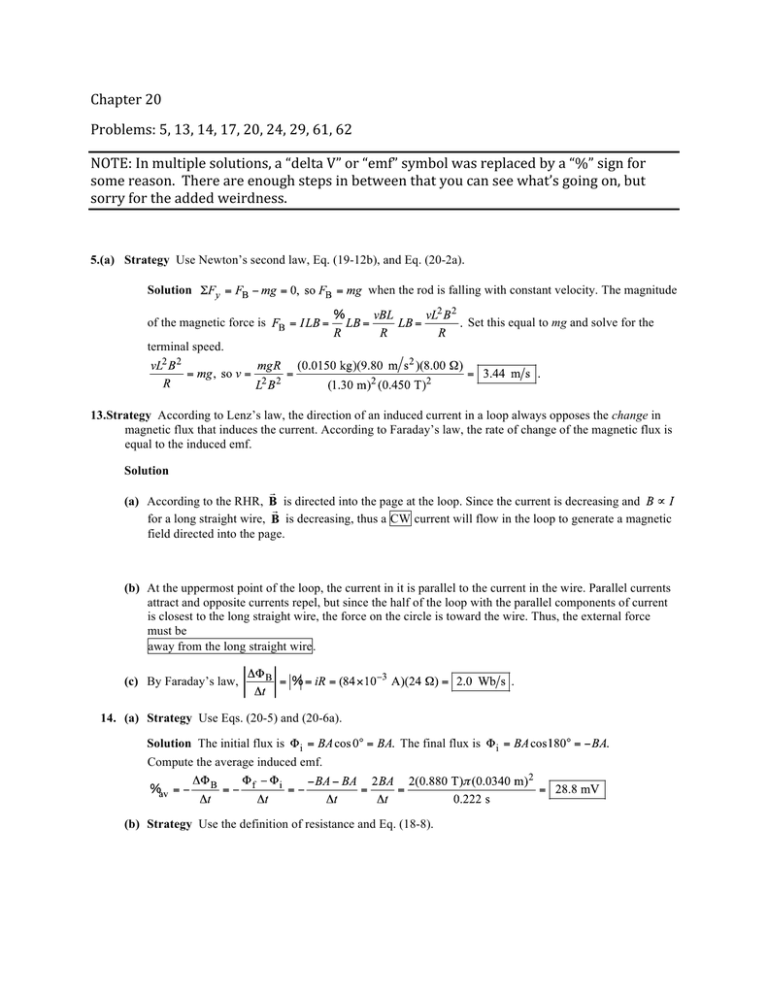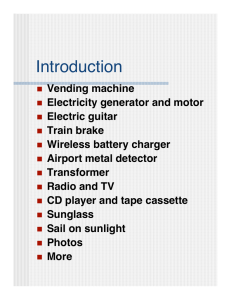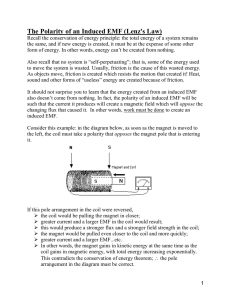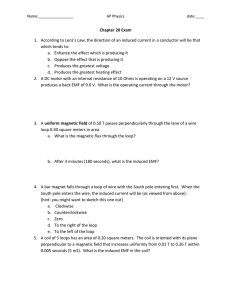5, 13, 14, 17, 20, 24, 29, 61, 62
advertisement

Chapter 20 Problems: 5, 13, 14, 17, 20, 24, 29, 61, 62 NOTE: In multiple solutions, a “delta V” or “emf” symbol was replaced by a “%” sign for some reason. There are enough steps in between that you can see what’s going on, but sorry for the added weirdness. 5.(a) Strategy Use Newton’s second law, Eq. (19-12b), and Eq. (20-2a). Solution when the rod is falling with constant velocity. The magnitude of the magnetic force is Set this equal to mg and solve for the terminal speed. 13.Strategy According to Lenz’s law, the direction of an induced current in a loop always opposes the change in magnetic flux that induces the current. According to Faraday’s law, the rate of change of the magnetic flux is equal to the induced emf. Solution (a) According to the RHR, is directed into the page at the loop. Since the current is decreasing and for a long straight wire, is decreasing, thus a CW current will flow in the loop to generate a magnetic field directed into the page. (b) At the uppermost point of the loop, the current in it is parallel to the current in the wire. Parallel currents attract and opposite currents repel, but since the half of the loop with the parallel components of current is closest to the long straight wire, the force on the circle is toward the wire. Thus, the external force must be away from the long straight wire. (c) By Faraday’s law, 14. (a) Strategy Use Eqs. (20-5) and (20-6a). Solution The initial flux is The final flux is Compute the average induced emf. (b) Strategy Use the definition of resistance and Eq. (18-8). Solution Compute the average current that flows through the coil. 17. Strategy According to Lenz’s law, the direction of an induced current in a loop always opposes the change in magnetic flux that induces the current. Solution (a) When the switch is closed, the CW flowing current in the large coil increases from zero to its maximum value. This current generates a magnetic field directed to the right that increases as the current increases. A current in the small coil is induced creating a field that opposes the increasing magnetic field and, thus, its direction of flow is to the right. (b) The situation is opposite to that found in part (a) (I and B decrease). So, the current flows to the left. 20.Strategy According to Lenz’s law, the direction of an induced current in a loop always opposes the change in magnetic flux that induces the current. Solution (a) When the switch is closed, a CW directed current flows in loop 1 and generates a magnetic field directed out of the page in loop 2. For a short time, as the current is increasing, the magnetic field also increases, and a current is induced in loop 2 to oppose it. The field generated by the induced current must be directed into the page, so the current flows CW. (b) Unless loop 2 has zero resistance, the current only flows for a brief moment, just past the time that the current in loop 1 stops increasing. (c) Due to symmetry, the vertical component of the force is zero. According to the RHR, the net force of the left side is directed to the right, and that on the right is directed to the left, but because and B decreases with distance, the net force on the ring is directed to the right. (d) The magnetic field due to loop 2 at loop 1 is out of the page. By reasoning similar to that in part (c), the force is to the left. (I and have the same direction, but the field at the right side of the loop is stronger.) 24. Strategy Use Eq. (20-9). Solution Compute the secondary voltage amplitude. 29. Strategy Use Eq. (20-9). Solution Compute the number of turns required for the secondary coil. 61. Strategy According to Faraday’s law, the magnitude of the induced emf around a loop is equal to the rate of change of the magnetic flux through the loop. According to Lenz’s law, the direction of an induced current in a loop always opposes the change in magnetic flux that induces the current. Solution As the bar magnet travels from 1 to 2, is increasing and to the left at the coil. As viewed from the left, a CW current is induced in the coil that generates a magnetic field to the right to oppose the increasing magnetic field due to the bar magnet. Thus, the current is negative and increasing in magnitude. As the is decreasing and to the left at the coil. The induced current flows I bar magnet travels from 2 to 3, CCW to oppose the decreasing field. Thus, the current is positive and decreasing in magnitude. 1 3 Position 2 62. Strategy According to Faraday’s law, the magnitude of the induced emf around a loop is equal to the rate of change of the magnetic flux through the loop. According to Lenz’s law, the direction of an induced current in a loop always opposes the change in magnetic flux that induces the current. Solution (a) The magnetic field is directed to the right inside the coil. As the magnet approaches, the magnetic field increases. A current in the coil is generated to oppose this increase. The field due to the current is directed to the left, so according to the RHR, the current flows CCW as viewed from the left, or to the right through the galvanometer. (b) In this case, the field is still to the right, but it is decreasing. So, the current must flow in the opposite direction, or CW. Then the current flows to the left through the galvanometer. (c) The current is proportional to the induced emf and the induced emf is proportional to the number of turns, so (d) The current is proportional to the induced emf and the induced emf is proportional to the speed of the magnet, so (e) The magnetic field strength doubles, so the rate of change of the flux also doubles. This implies a doubling of the induced emf and, thus, the current doubles. (f) With the bar magnets held with the opposite poles together, the net magnetic flux through the coil is zero, so the current is reduced to zero. (g) Yes, both cases give similar results. This case is the same as the previous case but only in a different reference frame. Either reference frame is equally valid: in one frame, the induced emf is due to the motion of the conductor (moving coil); in the other, the induced emf is due to a changing magnetic field (moving bar magnet).







